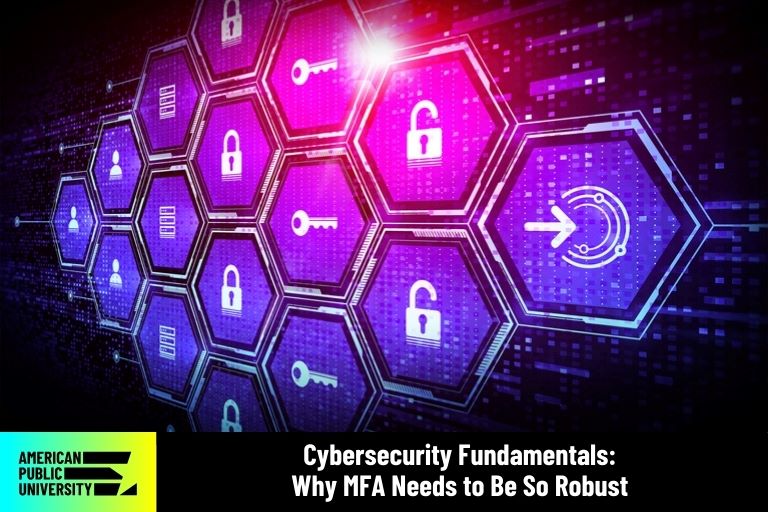By Dr. Andre Slonopas | 01/31/2024

Strong cybersecurity principles are crucial in protecting systems in our fast-changing online age. With technology and the internet involved in every aspect of business and society, the protection of sensitive information and critical infrastructures and learning cybersecurity fundamentals is vital. From sophisticated cyber attacks to malware and fraud, cybersecurity threats affect system and data integrity, confidentiality, and availability.
What Is MFA?
Multi-Factor Authentication (MFA), a cornerstone of security solutions, protects networks and systems against illegal entry. This security solution protects organizations and users against typical cyber attacks and restricts intrusion, so that essential resources are only available to authorized users.
Since attackers are becoming better at breaking through conventional security barriers, corporations and cybersecurity experts are concentrating more on MFA. It protects businesses and critical infrastructures by building layers of security to block attackers.
Why It's Necessary to Incorporate Cybersecurity Fundamentals in Cybersecurity Education
Cybersecurity fundamentals courses and certifications must include basic information on ethical hacking, system protection, encryption, application security, and other foundational skills. Learning these cybersecurity fundamentals help students and cybersecurity professionals predict and defend against cyberattacks.
Also, attackers constantly change their tactics as they discover new vulnerabilities. As a result, cybersecurity specialists must constantly learn and adapt to new vulnerabilities to protect networks, data, and systems.
Understanding Cybersecurity Fundamentals such as Threats and Cyber Attacks
Understanding cyber threats is crucial to learning cybersecurity fundamentals. Deliberate efforts to compromise a person or organization's information jeopardizes sensitive data's confidentiality, integrity, and availability. Cybersecurity experts categorize these attacks by attackers’ approach methods and goals.
Malware, phishing, and Distributed Denial of Service (DDoS) are common types of cyberattacks. Malware attacks, such as viruses and ransomware, harm systems or steal data. However, phishing schemes use misleading emails or websites to steal personal information. DDoS attacks cripple systems and block genuine users.
Significant real-world instances demonstrate the need for cybersecurity. Using Microsoft Windows vulnerabilities, the 2017 WannaCry ransomware damaged companies and organizations worldwide, emphasizing the necessity for current digital network cybersecurity. Similarly, employee cybersecurity training became crucial after a 2013 phishing email incident at Target® exposed millions of pieces of consumer data.
These cyberattacks show the changing nature of cyber threats, the relevance of cybersecurity solutions, and the continued difficulty of defending networks, computer systems, and infrastructure from sophisticated cybercriminals. Businesses must first understand these dangers to establish effective ways to defend their digital assets and preserve confidence in the digital economy.
The Role of MFA
Protecting infrastructure, networks, and critical information against cyberattacks is the goal of teaching and learning cybersecurity fundamentals. MFA is essential to the security of digital infrastructure; MFA makes it harder for attackers to compromise sensitive data by demanding several verifications to reach a computer or network.
MFA is built upon the idea that a network entry point should entail many levels of security, making it difficult for unauthorized users to breach a network. These layers usually contain:
- Something a user knows (like a password)
- Something a user has (such as a security token or mobile device)
- Something a user is (a biometric identifier like the use of facial recognition)
MFA is more secure than single-factor authentication since it combines knowledge and validation, greatly reducing the risk that unauthorized users can gain access to sensitive information.
MFA has several benefits, especially in its ability to protect against typical threats like phishing and credential abuse. Traditional security mechanisms generally use passwords, which are all too easily hacked.
MFA, however, adds security layers that make it nearly impossible for malicious actors to gain access to a network or server. MFA safeguards infrastructure against cybercrime in network security.
Network entry points are secured to prevent intrusion to important corporate data and systems. Industries that value data privacy and integrity need this type of protection.
Organizations using MFA demonstrate their strong commitment to cybersecurity, which not only protects against cyberattacks but also boosts public confidence in their online services. Cybersecurity education on basic concepts and certification programs stress MFA, giving prospective cybersecurity professionals the tools and expertise to manage and mitigate increasing cyber hazards.
As technology advances and cyber attackers grow more adept, MFA will become even more important in cybersecurity. It's crucial to a complete security plan, ensuring company and consumer digital safety.
Implementing Security Solutions: Integrating MFA
Adding MFA to an organization's cyber security policy can reduce cyber attack risk. The use of MFA requires a disciplined strategy that includes assessing cybersecurity concepts, identifying company objectives, and teaching people about new security procedures.
It’s essential to determine the systems and services where MFA will work best. This work generally involves risk analysis to pinpoint how unauthorized users could gain access to confidential information and important business activities.
Once these vulnerabilities are recognized, companies must choose the right MFA technology for their needs. That may involve using tokens, biometrics, smartphone applications, or other technologies.
Before deployment, MFA solutions should be tested in a controlled environment to discover faults and ensure infrastructure compatibility. MFA effectiveness relies on user compliance and knowledge, so enterprises should offer extensive training and assistance.
MFA implementation, however, can be very challenging and difficult for several reasons. First, user reluctance to participate in extra security measures is a major issue. To combat this reluctance, cyber security experts must clearly communicate the necessity of MFA in guarding against typical cyber attacks.
Second, technical integration with current security infrastructure is another issue, particularly in complex IT setups. Organizations must verify that MFA solutions fit with their technological stack and don't interrupt existing processes, which may involve vendor coordination and MFA solution customization.
Third, MFA system maintenance and updates are essential. MFA technology must adapt to changing vulnerabilities, so regular assessments and upgrades based on cyber security principles and industry best practices are needed.
In cybersecurity courses and certification programs, MFA implementation skills are becoming more important. Instructors are emphasizing practical MFA applications to teach students how to apply MFA solutions in real-world situations.
MFA integration within an organization's cybersecurity strategy has certain drawbacks, but the security and cyber attack risk advantages outweigh them. MFA may boost cybersecurity protections if used properly.
MFA as a Response to Rising Digital Threats
Businesses in the digital era confront many dangers when addressing cybersecurity fundamentals, making MFA essential to preserve security. MFA’s extra security layers make it tougher for hackers to get in. For instance, MFA prevents phishing, credential stuffing, and brute-force attacks by requiring numerous user verifications.
MFA's ability to mitigate password weaknesses makes it an effective form of protection. By adding verification elements, MFA minimizes the chance of a single compromised password causing a security breach, which is crucial for preventing phishing attacks that steal user credentials. Although hackers can get a password using MFA, they cannot gain access to the system.
Case examples in diverse sectors demonstrate MFA's efficacy. Online fraud and illegal gain to account access have decreased in the banking industry due to MFA. For instance, one large bank uses MFA for all online transactions, reducing the potential for fraud.
MFA has prevented data breaches in the healthcare sector, where patient data is vital. A hospital network that implemented MFA for each of its systems saw a considerable decline in unwanted access attempts, demonstrating its practicality.
Building knowledge about MFA efficacy is very important in cybersecurity courses and certification pathways. Instructors help promote MFA in cybersecurity by teaching MFA implementation and management skills. Case studies and real-world examples in these training resources help students learn how MFA can safeguard against cyber dangers.
MFA remains a powerful cybersecurity defense as situations change. Its capacity for protecting vital information makes it essential to a cybersecurity strategy, particularly as cyber attacks become more complex.
Comprehensive Cyber Security: Beyond MFA
Learning cybersecurity fundamentals such as MFA is essential in business and other sectors; however, it cannot protect against all cyber attacks. Successful cybersecurity protection requires a comprehensive strategy using several techniques and procedures. MFA must be combined with sophisticated cryptography, secure internet protocols, and cybersecurity training in one integrated strategy.
Integrating MFA with other cybersecurity technologies and regulations is crucial to cybersecurity. For instance, MFA and strong encryption safeguard critical online data. MFA, firewalls, and secure network protocols offer multi-layered protection against cyber attacks.
Cybersecurity experts require training and certification to deploy a complete portfolio of safeguarding methodologies. Each course should cover everything from cybersecurity fundamentals to sophisticated technologies and methods, combining theory and practice.
Future cybersecurity solutions are predicted to emerge. Machine learning and artificial intelligence are expected to improve cybersecurity. These innovations might lead to more advanced and automated solutions that use MFA as part of a bigger, more dynamic framework.
A comprehensive cybersecurity plan becomes more important as cyber attacks grow more sophisticated. Enterprises must embrace MFA, invest in a variety of solutions, and remain abreast of cybersecurity trends and best practices.
American Public University: Pioneering Cybersecurity Education
American Public University (APU) has added MFA to its comprehensive cybersecurity program, continuing its academic leadership in the field. MFA is crucial to fighting cyber attacks, and APU’s courses address MFA while teaching cybersecurity fundamentals to students. This knowledge helps to equip our graduates with the knowledge and abilities to develop and maintain MFA solutions in professional contexts.
APU's cybersecurity programs benefit from its faculty of subject matter experts (SMEs) in their respective industries. This real-world experience makes course materials about important technologies like firewalls and cryptography for encryption academically sound, providing learners with the skills for a plethora of real-world applications. Our faculty's professional cybersecurity industry involvement lets them bring current trends and practical expertise to the classroom.
The National Security Agency (NSA) has designated APU’s parent, American Public University System, as a Center of Academic Excellence in Cyber Defense (CAE-CD) for its cybersecurity curriculum. This honor recognizes our programs' quality and application, especially in vital areas like defense of network infrastructures, computers, and digital architecture protection.
APU’s cybersecurity curriculum helps equip learners to combat growing cyber threats with its thorough study of cybersecurity fundamentals, sophisticated technology, and practical skills. Our graduates, with a comprehensive grasp of cybersecurity ideas and hands-on experience in deploying solutions like MFA, are prepared to safeguard sensitive materials and secure vital networks, contributing to cybersecurity.
Target® is a registered trademark of Target Brands, Inc.
CISM is an Information Systems Audit and Control Association, Inc. registered trademark.

